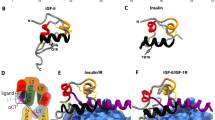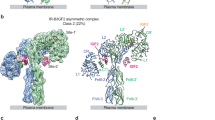Abstract
IGF-II, produced by breast cancer epithelial and stromal cells, enhances tumor growth by activating the IGF-I receptor (IGF-I-R) via autocrine and paracrine mechanisms. Previously we found that the insulin receptor (IR), which is related to the IGF-I-R, is overexpressed in breast cancer cells. Herein, we find that, in breast cancer the IR is activated by IGF-II. In eight human breast cancer cell lines studied there was high affinity IGF-II binding to the IR, with subsequent IR activation. In these lines, IGF-II had a potency up to 63% that of insulin. In contrast, in non malignant human breast cells, IGF-II was less than 1% potent as insulin. Via activation of the IR tyrosine kinase IGF-II stimulated breast cancer cell growth. Moreover, IGF-II also activated the IR in breast cancer tissue specimens; IGF-II was 10 – 100% as potent as insulin. The IR occurs in two isoforms generated by alternative splicing of exon 11; these isoforms are IR-A (Ex11−) and IR-B (Ex11+). IR-A was predominantly expressed in breast cancer cells and specimens and the potency of IGF-II was correlated to the expression of this isoform (P<0.0001). These data indicate, therefore, that the IR-A, which binds IGF-II with high affinity, is predominantly expressed in breast cancer cells and represents a new autocrine/paracrine loop involved in tumor biology.
This is a preview of subscription content, access via your institution
Access options
Subscribe to this journal
Receive 50 print issues and online access
$259.00 per year
only $5.18 per issue
Buy this article
- Purchase on Springer Link
- Instant access to full article PDF
Prices may be subject to local taxes which are calculated during checkout






Similar content being viewed by others
References
Arteaga CL and Osborne K. . 1989 Cancer Res. 49: 6237–6241.
Belfiore A, Costantino A, Frasca F, Pandini G, Mineo R, Vigneri P, Goldfine ID and Vigneri R. . 1996 Mol. Endocrinol. 10: 1318–1326.
Carmichael J, DeGraff WG, Gazdar AF, Minna JD and Mitchell JB. . 1996 Cancer Res. 47: 943–946.
Cullen KJ, Allison A, Martire I, Ellis M and Singer C. . 1992a Breast Cancer Res. Treat. 2: 21–29.
Cullen KJ, Lippman ME, Chow D, Hill S, Rosen N and Zwiebel JA. . 1992b Mol. Endocrinol. 6: 91–100.
Dickson RB and Lippman M. . 1995 Endocrin. Rev. 16: 559–565.
Ebina Y, Ellis L, Jarnaglin K, Edery M, Graf L, Clauser E, Ou JH, Masirz F, Kan YW, Goldfine ID, Roth RA and Rutter WJ. . 1985 Cell 40: 747–758.
Enjoh T, Hizuka N, Perdue JF, Takano K, Fujiwara H, Higashihashi N, Marumoto Y, Fukuda I and Sakano K-I. . 1996 J. Clin. Endocrin. Metab. 77: 510–517.
Forsayeth JR, Montemurro A, Maddux BA, DePirro R and Goldfine ID. . 1987 J. Biol. Chem. 262: 4134–4140.
Frasca F, Pandini G, Scalia P, Sciacca L, Mineo R, Costantino A, Goldfine ID, Belfiore A and Vigneri R. . 1999 Mol. Cell. Biol. 19: in press.
Frittitta L, Vigneri R, Stampfer MR and Goldfine ID. . 1995 J. Cell. Biochem. 57: 666–669.
Ganderton RH, Stanley KK, Field CE, Coghlan MP, Soos MA and Siddle K. . 1987 Biochem. J. 288: 195–205.
Giorgino F, Belfiore A, Milazzo G, Costantino A, Maddux B, Whittaker J, Goldfine ID and Vigneri R. . 1991 Mol. Endocrinol. 5: 452–459.
Gustafson TA and Rutter WJ. . 1987 J. Biol. Chem. 265: 18663–18667.
Jonas HA and Cox AJ. . 1992 Biochem. J. 266: 737–742.
Jonas HA, Cox AJ and Harrison LC. . 1992 Biochem. J. 257: 101–107.
Jonas HA, Eckardt GS and Clark S. . 1990 Endocrinology 127: 1301–1309.
Kull FC, Jacobs S, Su YF, Svoboda ME, Van Wyk JJ and Cuatrecasas P. . 1987 J. Biol. Chem. 258: 6561–6566.
Louvi A, Accili D and Efstratiadis A. . 1997 Dev. Biol. 189: 33–48.
Mathieu MC, Clark GM, Allred DC, Goldfine ID and Vigneri R. . 1997 Proc. Assoc. Am. Phys. 109: 565–571.
Milazzo G, Giorgino F, Damante G, Sung C, Stampfer MR, Vigneri R, Goldfine ID and Belfiore A. . 1992a Cancer Res. 52: 3924–3930.
Milazzo G, Yip CC, Maddux BA, Vigneri R and Goldfine ID. . 1992b J. Clin. Invest. 89: 899–908.
Morrione A, Valentinis B, Xu S-q, Yumet G, Louvi A, Efstratiadis A and Baserga R. . 1997 Proc. Natl. Acad. Sci. USA 94: 3777–3782.
Osborne CK, Coronado EB, Kitten LJ, Arteaga CI, Fuqua SAW, Ramasharma K, Marshall M and Li CH. . 1989 Mol. Endocrin. 3: 1701–1709.
Papa V and Belfiore A. . 1996 J. Endocrin. Invest. 19: 324–333.
Papa V, Pezzino V, Costantino A, Belfiore A, Giuffrida D, Frittitta L, Vannelli GB, Brand R, Goldfine ID and Vigneri R. . 1990 J. Clin. Invest. 86: 1503–1510.
Podskalny JM, Rouiller DG, Grunberger G, Baxter RC, McElduff A and Gorden P. . 1986 J. Biol. Chem. 261: 14076–14081.
Soos MA, Field CE, Lammers R, Ullrich A, Zhang B, Roth RA, Andersen AS, Kjeldsen T and Siddle K. . 1992 J. Biol. Chem. 267: 12955–12963.
Steller MA, Delgado CH, Bartels CJ, Woodworth CD and Zou Z. . 1996 Cancer Res. 56: 1761–1765.
Ullrich A, Gray A, Tam AW, Yang-Feng T, Tsubokawa M and Collins C. . 1986 EMBO J. 5: 2503–2512.
Yamaguchi Y, Flier JS, Yokota A, Benecke H, Backer JM and Moller DE. . 1991 Endocrinology 129: 2058–2066.
Acknowledgements
This work was supported in part by the Associazione Italiana Ricerca sul Cancro (AIRC Milan, Italy), MURST 60% (Italy), the JA Kerner Foundation, the J Gershow Cancer Fund, and the Ladies Auxiliary of Veterans of Foreign Wars (USA). L Sciacca is recipient of an AIRC fellowship, R Mineo is recipient of a FIRC (Federazione Italiana Ricerca sul Cancro) fellowship.
Author information
Authors and Affiliations
Rights and permissions
About this article
Cite this article
Sciacca, L., Costantino, A., Pandini, G. et al. Insulin receptor activation by IGF-II in breast cancers: evidence for a new autocrine/paracrine mechanism. Oncogene 18, 2471–2479 (1999). https://doi.org/10.1038/sj.onc.1202600
Received:
Revised:
Accepted:
Published:
Issue Date:
DOI: https://doi.org/10.1038/sj.onc.1202600
Keywords
This article is cited by
-
Metformin counteracts stimulatory effects induced by insulin in primary breast cancer cells
Journal of Translational Medicine (2022)
-
Targeting obesity-related dysfunction in hormonally driven cancers
British Journal of Cancer (2021)
-
Identification of a novel EphB4 phosphodegron regulated by the autocrine IGFII/IRA axis in malignant mesothelioma
Oncogene (2019)
-
IGF-IR signaling in epithelial to mesenchymal transition and targeting IGF-IR therapy: overview and new insights
Molecular Cancer (2017)
-
Overproduction of IGF-2 drives a subset of colorectal cancer cells, which specifically respond to an anti-IGF therapeutic antibody and combination therapies
Oncogene (2017)



